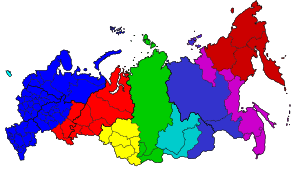Time in Russia
There are eleven time zones in Russia, which currently observe times ranging from UTC+02:00 to UTC+12:00. Daylight saving time is not used in Russia (since 26 October 2014). From 27 March 2011 to 26 October 2014, permanent DST was used.
.svg.png)
| KALT | Kaliningrad Time | UTC+2 | (MSK−1) | |
| MSK | Moscow Time | UTC+3 | (MSK±0) | |
| SAMT | Samara Time | UTC+4 | (MSK+1) | |
| YEKT | Yekaterinburg Time | UTC+5 | (MSK+2) | |
| OMST | Omsk Time | UTC+6 | (MSK+3) | |
| KRAT | Krasnoyarsk Time | UTC+7 | (MSK+4) | |
| IRKT | Irkutsk Time | UTC+8 | (MSK+5) | |
| YAKT | Yakutsk Time | UTC+9 | (MSK+6) | |
| VLAT | Vladivostok Time | UTC+10 | (MSK+7) | |
| MAGT | Magadan Time | UTC+11 | (MSK+8) | |
| PETT | Kamchatka Time | UTC+12 | (MSK+9) |
List of zones
Since 28 October 2018, the time zones are as follows:[1][2]
Daylight saving time
Daylight saving time in Russia was originally introduced on 1 July [14 July, N.S.] 1917 by a decree of the Russian Provisional Government. However, it was abandoned by a Decree of the Soviet government six months later.
Daylight saving time was re-introduced in the USSR in 1981, beginning on 1 April and ending on 1 October each year, until mid-1984, when the USSR began following European daylight saving time rules, moving clocks forward one hour at 02:00 local standard time on the last Sunday in March, and back one hour at 03:00 local daylight time on the last Sunday in September until 1995, after which the change back occurred on the last Sunday in October.
On 27 March 2011, clocks were advanced as usual, but they did not go back on 30 October 2011, effectively making Moscow Time UTC+04:00 permanently.[4] On 26 October 2014, following another change in the law, the clocks in most of the country were moved back one hour, but summer Daylight Time was not reintroduced; Moscow Time returned to UTC+03:00 permanently.[5]
History
Russian Empire
In the Russian Empire, most of the nation observed solar time. From 1740s to 1867, Alaska belonged to Russia (Russian America) which used the Julian calendar which was 11 or 12 days behind the Gregorian calendar as the rest of Russia and had local times up to GMT+15:10. The westernmost area of Russia was Congress Poland, with local times down to GMT+01:10.
During the late 19th century, Moscow Mean Time was introduced on 1 January [13 January, N.S.] 1880, originally at GMT+02:30:17.[6] 2:30:17 corresponds to 37.6166667°, the longitude of Moscow. Other parts of Russia kept solar time for several years.
Russia adopted the Gregorian calendar in 1918, when Wednesday 31 January (O.S.) was followed by Thursday 14 February (N.S.), which dropped 13 days from the calendar.
Soviet Union
After the Soviet Union was created, Moscow Time became UTC+02:00 and the various other time zones (up to UTC+12:00) were introduced throughout Russia and the rest of the Soviet Union, for example Irkutsk Time UTC+07:00 (Irkutsk has since this always been MSK+5).[6] Between 1917-1922 the time was less ordered, with daylight saving time some of those years, some with two hours addition, and some of those years with one or two hours extra winter time.[6]
On 21 June 1930, the Soviet Union advanced all clocks by one hour, effectively making the nation run on daylight saving time all year (the so-called decree time).
On 1 April 1981, 00:00:00, Oymyakonsky District changed its time zone from MSK+6 to MSK+8.[7]
The change occurred during DST effectively changing the offset from UTC+09:00 to UTC+12:00, the offset without DST was therefore changed from UTC+09:00 to UTC+11:00.
On 1 April 1982, 00:00:00, Chukotka Autonomous Okrug changed its time zone from MSK+10 to MSK+9, thus eliminating Anadyr Time (MSK+10 or UTC+13:00 without DST).[8]
The change occurred during DST effectively changing the offset from UTC+14:00 to UTC+13:00, the offset without DST was therefore changed from UTC+13:00 to UTC+12:00.
On 27 March 1988, 02:00:00, Saratov and Volgograd oblasts changed its time zone from MSK+1 to MSK.[9][10]
The change occurred during DST effectively changing the offset from UTC+05:00 to UTC+04:00, the offset without DST was therefore changed from UTC+04:00 to UTC+03:00.
On 26 March 1989, the following changes were introduced, which, in particular, some oblasts switched to Moscow Time (thus eliminating Samara Time; MSK+1 or UTC+04:00 without DST):
- Astrakhan Oblast
- Kirov Oblast
- Kuybyshev Krai
- Ulyanovsk Oblast
Some oblasts switched from Moscow Time to Eastern European Time:
Russian Federation
Russia and most republics in the Soviet Union abolished the decree time (not moving the clocks) on 31 March 1991, but Russia reversed this the following year (except Samara Oblast which was already in UTC+04:00).
On 20 October 1991, Samara Oblast changed its time zone from MSK to MSK+1 (thus reinstating Samara Time; MSK+1). So the zone boundaries on 20 October, Samara Oblast changed its time zone from UTC+03:00 to UTC+04:00.[11]
On 23 May 1993, Novosibirsk Oblast changed its time zone from MSK+4 to MSK+3.[12]
The change occurred during DST effectively changing the offset from UTC+08:00 to UTC+07:00, the offset without DST was therefore changed from UTC+07:00 to UTC+06:00.
On 28 May 1995, Altai Krai and Altai Republic changed its time zone from MSK+4 to MSK+3.[13]
On 30 March 1997, Sakhalin Oblast changed its time zone from MSK+8 to MSK+7.[14]
In May 2002, Tomsk Oblast changed its time zone from MSK+4 to MSK+3.[15]
The following time zone changes occurred on 28 March 2010, which, in particular, led to abolition of two of the eleven time zones.
- Chukotka Autonomous Okrug and Kamchatka Krai started using Magadan Time, thus eliminating Kamchatka Time (MSK+9 or UTC+12:00 without DST).[16]
- Kemerovo Oblast started using Omsk Time.[17]
- The Udmurt Republic and Samara Oblast started using Moscow Time, thus eliminating Samara Time (MSK+1 or UTC+04:00 without DST).[18][19]
Although the Russian government wants to reduce the number of time zones even further, there have been protests in far-eastern Russia on the recent changes, including protests and a 20,000-strong petition in support of Kamchatka returning to UTC+12:00.[20]
The decree No. 725[21] (31 August 2011) changed UTC offset for Moscow Time and the other time zones. Moscow Time Zone now used UTC+04:00 all year around. The notions of decree time and daylight saving time were abolished in the law, but in fact, this law mandated permanent daylight saving time (or even double daylight saving time in regions that had not abolished the decree time). Some areas changed offset from Moscow:
Some districts of the Sakha Republic switched from Magadan Time (Zone 9) to Vladivostok Time (from Zone 8):
Some districts of the Sakha Republic switched from Vladivostok Time (Zone 8) to Yakutsk Time (Zone 7):
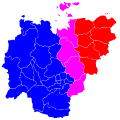 28 March 2010 (with DST)
28 March 2010 (with DST)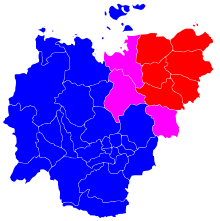 13 September 2011 ("permanent DST")
13 September 2011 ("permanent DST")
Blue Yakutsk Time (MSK+6), pink Vladivostok Time (MSK+7), red Magadan Time (MSK+8).
.svg.png)
As a result of the annexation of Crimea by the Russian Federation, local authorities in the Republic of Crimea and Sevastopol decreed that clocks in the newly proclaimed Russian federal subjects should jump ahead two hours at 10 p.m. on 29 March 2014 to switch from Eastern European Time (UTC+02:00) to Moscow Time (UTC+04:00).[22]
On 22 July 2014, further changes were passed, which took effect on 26 October 2014. All of Russia moved back one hour, so Moscow Time became UTC+03:00 again. Some areas changed offset from Moscow:[23]
- Chukotka Autonomous Okrug and Kamchatka Krai remained on UTC+12:00 (thus reinstating Kamchatka Time, MSK+9)
- Magadan Oblast moved back two hours to UTC+10:00 (went from Magadan Time, MSK+8 to Vladivostok Time, MSK+7)
- The parts of the Magadan Time zone that remained on MSK+8, were given a new time zone name, Srednekolymsk Time, UTC+11:00.
- Zabaykalsky Krai moved back two hours to UTC+08:00 (went from Yakutsk to Irkutsk Time)
- Kemerovo Oblast remained on UTC+07:00 (went from Omsk to Krasnoyarsk Time)
- Udmurtia and Samara Oblast remained on UTC+04:00 (thus reinstating Samara Time, MSK+1)
Annual DST changes is not observed.[24]
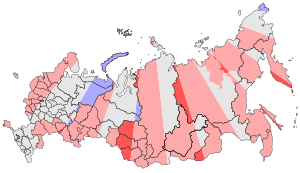
The following time zone changes occurred on 27 March 2016:[25]
- Sakhalin Oblast moved forward one hour from UTC+10:00 to UTC+11:00 (from Vladivostok to Srednekolymsk time), except Severo-Kurilsky District, which was already in UTC+11:00 (Srednekolymsk Time)
- Zabaykalsky Krai moved forward one hour from UTC+08:00 to UTC+09:00 (from Irkutsk to Yakutsk time)
- Altai Krai and Altai Republic moved forward one hour from UTC+06:00 to UTC+07:00 (from Omsk to Krasnoyarsk time)
- Astrakhan and Ulyanovsk oblasts moved forward one hour from UTC+03:00 to UTC+04:00 (from Moscow to Samara time)
The following time zone change occurred on 24 April 2016:[26]
- Magadan Oblast moved forward one hour from UTC+10:00 to UTC+11:00 (from Vladivostok to Srednekolymsk time)
After these changes, the UTC+11:00 time zone is also named Magadan Time, Srednekolymsk Time or Sakhalin Time.[27]
The following time zone change occurred on 29 May 2016:[28]
- Tomsk Oblast moved forward one hour from UTC+06:00 to UTC+07:00 (from Omsk to Krasnoyarsk time)
The following time zone change occurred on 24 July 2016:[29]
- Novosibirsk Oblast moved forward one hour from UTC+06:00 to UTC+07:00 (from Omsk to Krasnoyarsk time)
The following time zone change occurred on 4 December 2016:[30][31]
- Saratov Oblast moved forward one hour from UTC+03:00 to UTC+04:00 (from Moscow to Samara time)
The following time zone change occurred on 28 October 2018:[32]
- Volgograd Oblast moved forward one hour from UTC+03:00 to UTC+04:00 (from Moscow to Samara time)
Railway time
Until 2018, all timetables on Russian Railways (except Sakhalin railways) followed Moscow Time. From 2018 time tables follow local time.[33] [34] Airports and flights follow local time.[35]
Tz Database
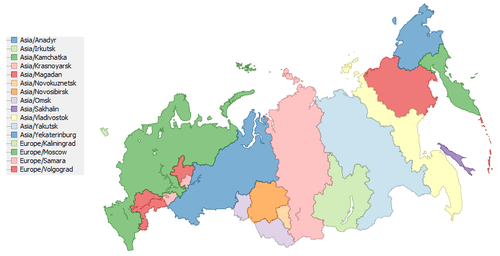
For Russia, the tz database contains several zones in the file zone.tab.
List of zones
The list below shows the 16 zones for Russia as defined in the file zone.tab of the database. The database aims to identify regions that had the same time offset rules since 1970.
Two federal subjects are contained in more than one tz zone. The Sakha Republic is divided into three: west, central, east. Sakhalin Oblast is divided into two: Sakhalin Island with Kurilsky and Yuzhno-Kurilsky districts in the Kuril Islands, and Severo-Kurilsky District in the Kuril Islands.
On the last Sunday in October 2011, daylight-saving time ended in tzdata, but all zones moved forward one hour. In other words, the clocks did not change, but the names of the time zones reverted permanently to their standard time variants and there will be no more daylight-saving time.
If available, the change column lists the offset changes that caused a creation of a new zone in the tz database.
"Initial zone" means that in 1970 there was already a difference in time offset from the offsets in any other zone.
| C.c. | Coordinates | tzid | Comments | UTC offset (without DST, permanent since 2011) | Covered area | Split from | Changes |
|---|---|---|---|---|---|---|---|
| RU | +5443+02030 | Europe/Kaliningrad | Moscow-01 - Kaliningrad | +02:00 | Kaliningrad Oblast | Initial zone | 1989-03-26 Change from UTC+03:00 to UTC+02:00 |
| RU | +5545+03735 | Europe/Moscow | Moscow+00 - west Russia | +03:00 | Most of European Russia. Complete list given here. | Initial zone | |
| RU | +4844+04425 | Europe/Volgograd | Moscow+00 - Caspian Sea | +04:00 | Kirov Oblast, Saratov Oblast, Volgograd Oblast, and Astrakhan Oblast | Europe/Samara | 1992-03-29 Zone creation, causing change from UTC+04:00 to UTC+03:00 |
| RU | +5312+05009 | Europe/Samara | Moscow+00 (Moscow+01 after 2014-10-26) - Samara, Udmurtia | +04:00 | Samara Oblast and Udmurtia | Initial zone | 2010-03-28 Change from UTC+04:00 to UTC+03:00 |
| RU | +5419+04822 | Europe/Ulyanovsk | +04:00 | Ulyanovsk Oblast | Europe/Moscow | 2016-03-27 Zone creation, causing change from UTC+03:00 to UTC+04:00 | |
| RU | +5651+06036 | Asia/Yekaterinburg | Moscow+02 - Urals | +05:00 | Bashkortostan, Chelyabinsk Oblast, Khanty–Mansi Autonomous Okrug, Kurgan Oblast, Orenburg Oblast, Perm Krai, Sverdlovsk Oblast, Tyumen Oblast, and Yamalia | Initial zone | |
| RU | +5500+07324 | Asia/Omsk | Moscow+03 - west Siberia | +06:00 | Altai Krai, Altai Republic, and Omsk Oblast | ||
| RU | +5502+08255 | Asia/Novosibirsk | Moscow+03 - Novosibirsk | +06:00 | Novosibirsk Oblast and Tomsk Oblast. | ||
| RU | +5345+08707 | Asia/Novokuznetsk | Moscow+03 (Moscow+04 after 2014-10-26) - Kemerovo | +07:00 | Kemerovo Oblast | Asia/Novosibirsk | 2010-03-28 Zone creation, causing change from Krasnoyarsk Time to Novosibirsk Time[37] |
| RU | +5601+09250 | Asia/Krasnoyarsk | Moscow+04 - Yenisei River | +07:00 | Khakassia, Krasnoyarsk Krai, and Tuva Republic | ||
| RU | +5216+10420 | Asia/Irkutsk | Moscow+05 - Lake Baikal | +08:00 | Irkutsk Oblast and Buryatia | ||
| RU | +6200+12940 | Asia/Yakutsk | Moscow+06 - Lena River | +09:00 | Amur Oblast, Zabaykalsky Krai, and western Sakha Republic | ||
| RU | +4310+13156 | Asia/Vladivostok | Moscow+07 - Amur River | +10:00 | Jewish Autonomous Oblast, Khabarovsk Krai, Primorsky Krai, and central Sakha Republic | Initial zone | |
| RU | +4658+14242 | Asia/Sakhalin | Moscow+07 - Sakhalin Island | +10:00 | Sakhalin Island, and western Kuril Islands | Asia/Magadan | 1997-03-30 Zone creation, causing change from UTC+11 to UTC+10 |
| RU | +643337+1431336 | Asia/Ust-Nera | Moscow+07 - Oymyakonsky | +10:00 | Oymyakonsky District | Asia/Yakutsk | 1981-04-01 Changed to Magadan time |
| RU | +5934+15048 | Asia/Magadan | Moscow+08 (Moscow+07 after 2014-10-26) - Magadan | +10:00 | Magadan Oblast | Initial zone | 2014-10-26 Split: Magadan Oblast changed to Vladivostok time, other areas using new Srednekolymsk time |
| RU | +6728+15343 | Asia/Srednekolymsk | Moscow+08 - E Sakha, N Kuril Is | +11:00 | eastern Kuril Islands, and eastern Sakha Republic | Asia/Magadan | 2014-10-26 |
| RU | +5301+15839 | Asia/Kamchatka | Moscow+08 (Moscow+09 after 2014-10-26) - Kamchatka | +12:00 | Kamchatka Krai | Initial zone | 2010-03-28 Change from UTC+12:00 to UTC+11:00 |
| RU | +6445+17729 | Asia/Anadyr | Moscow+08 (Moscow+09 after 2014-10-26) - Bering Sea | +12:00 | Chukotka Autonomous Okrug | Initial zone |
Deleted zones
Asia/Ulan Ude was a time zone identifier from the zone file of the tz database. The reference point was Ulan-Ude. It was added in tz version 2011e.[38] Edition 2011i did not contain it anymore. The area remained at Asia/Irkutsk. The contained data in zone.tab was:
RU +5150+10736 Asia/Ulan_Ude Moscow+05 - Buryatia
The covered area was Republic of Buryatia.
See also
References
- New time zones map of Russia from 28 October 2018, World Time Zone, 28 October 2018.
- Time Zones Currently Being Used in Russia, Timeanddate.com.
- Population of the Subjects of the Russian Federation, Russian Federal State Statistics Service, 2015.
- "Медведев отменил зимнее время". Lenta.ru. 8 February 2011. Retrieved 8 February 2011.
- Russian clocks go back for last time, BBC News, 25 October 2014
- Time Zone in Moscow, Russia
- Clock Changes in Ust-Nera, Russia in 1981. Timeanddate.com.
- Clock Changes in Anadyr, Russia in 1982. Timeanddate.com.
- Clock Changes in Saratov, Russia in 1988. Timeanddate.com.
- Clock Changes in Volgograd, Russia in 1988. Timeanddate.com.
- Clock Changes in Samara, Russia in 1991. Timeanddate.com.
- Time changes in year 1993 for Russia – Novosibirsk. Timeanddate.com. Retrieved on 2014-06-07.
- Clock Changes in Barnaul, Russia in 1995. Timeanddate.com.
- Clock Changes in Yuzhno-Sakhalinsk, Russia in 1997. Timeanddate.com.
- Clock Changes in Tomsk, Russia in 2002. Timeanddate.com.
- Правительство Российской Федерации. Постановление №171 от 19 марта 2010 г. «О применении на территории Камчатского края и Чукотского автономного округа времени десятого часового пояса». Опубликован: "Российская Газета", №58, 22 марта 2010 г. (Government of the Russian Federation. Resolution #171 of 19 March 2010 On Using the Time of the Tenth Time Zone on the Territory of Kamchatka Krai and Chukotka Autonomous Okrug. ).
- Правительство Российской Федерации. Постановление №740 от 14 сентября 2009 г. «О применении на территории Кемеровской области времени пятого часового пояса». (Government of the Russian Federation. Resolution #740 of 14 September 2009 On Using the Time of the Fifth Time Zone on the Territory of Kemerovo Oblast. ).
- Правительство Российской Федерации. Постановление №166 от 17 марта 2010 г. «О применении на территории Удмуртской Республики времени второго часового пояса». Опубликован: "Российская Газета", №58, 22 марта 2010 г. (Government of the Russian Federation. Resolution #166 of 17 March 2010 On Using the Time of the Second Time Zone on the Territory of the Udmurt Republic. ).
- Правительство Российской Федерации. Постановление №170 от 19 марта 2010 г. «О применении на территории Самарской области времени второго часового пояса». Опубликован: "Российская Газета", №58, 22 марта 2010 г. (Government of the Russian Federation. Resolution #170 of 19 March 2010 On Using the Time of the Second Time Zone on the Territory of Samara Oblast. ).
- "Thousands Protest Time Zone Changes in Russia". 13 December 2010. Retrieved 15 January 2011.
- Постановление Правительства Российской Федерации № 725 от 31 августа 2011 г. «О составе территорий, образующих каждую часовую зону, и порядке исчисления времени в часовых зонах, а также о признании утратившими силу отдельных постановлений Правительства Российской Федерации».
- "Crimea switches to Moscow time". Voice of Russia. 29 March 2014. Retrieved 29 March 2014.
- "New Russian time zones and the corresponding areas from October 26, 2014", World Time Zone, 22 July 2014.
- "Russia Moving to Permanent Winter Time From October 26", RIA Novosti 22 July 2014, retrieved 26 July 2014
- Russia Changes Several Time Zones, Timeanddate.com, 17 March 2016.
- Russia Changes Time Zone in Magadan, Timeanddate.com, 7 April 2016.
- https://www.timeanddate.com/time/zone/russia/magadan
- Proposed Time Change in Tomsk, Russia, Timeanddate.com, 27 April 2016.
- Proposed Time Change in Novosibirsk, Russia, Timeanddate.com, 5 July 2016.
- Proposed Time Change in Saratov, Russia, Timeanddate.com, 14 November 2016.
- Vladimir Putin signed law on time change in Saratov Oblast, Vzglyad-info, 22 November 2016. (in Russian)
- New Time Zone in Russia's Volgograd Region, Timeanddate.com, 3 October 2018.
- Russian trains to end dependence on Moscow time
- Russian Railways – Time tables
- for example http://www.iktport.ru/
- Новости NEWSru.com :: С 1 мая Томская область перешла в новый часовой пояс. Newsru.com. Retrieved on 2014-06-07.
- proposed time zone package changes. Gmane. Retrieved on 2014-06-07.
- proposeed time zone package changes Chile Russia Irkutsk Buryatia Morocco. Gmane. Retrieved on 2014-06-07.
External links
| Wikimedia Commons has media related to Time zones of Russia. |
| Wikinews has related news: |


